Planting, growing, outdoor care and propagation of basil
Basil is one of the most beloved herbs among gardeners. It looks beautiful in the garden, attracts pollinating insects, and protects fruit trees from pests. Green, red or purple glossy leaves accumulate at the time of flowering essential oils, thanks to which unique taste and aroma are created.
Residents of the southern regions cannot imagine meat dishes without basil, but in the middle zone and Siberia few people plant it, believing that the heat-loving plant will be reluctant to take root in the garden. However, if you know how to grow crops in open ground, you will be able to harvest the crop at the end of June.
Growing basil seedlings from seeds
Basil does not tolerate the slightest drop in temperature. Therefore, it is most often grown in seedlings. On a windowsill or in a greenhouse it is easy to create conditions for the germination of seed. Let's take a closer look at how to grow basil from seeds.
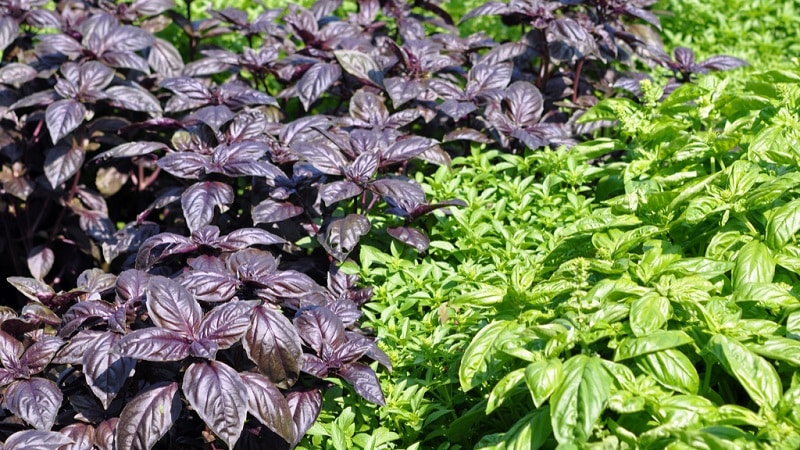
When to plant seeds
Here they focus on climatic conditions: in the south, seedlings are transferred to the ground already in May, and in middle and northern latitudes - in early or mid-June. The calculation is done in the opposite direction: it takes 7-8 days for seeds to germinate, about 2 months for plants to become stronger. This means that if the threat of frost usually passes by June 10, seeds are planted in early April.
Advice. In the northernmost regions, cold temperatures also occur in mid-June. There, basil is sown for seedlings in late April - early May.
Soil preparation
Prepare the soil for sowing in the following proportions::
- 1 part peat;
- 1 part humus;
- 1 part soil.
Before planting, the substrate is disinfected with a solution of potassium permanganate and fertilizer is applied. You can buy it ready-made or make it yourself. This will require 0.5 tsp. urea, superphosphate, potassium chloride, potassium sulfate and 5 liters of water. The mixture is thoroughly mixed and the soil in the prepared boxes or pots is watered.
Landing algorithm
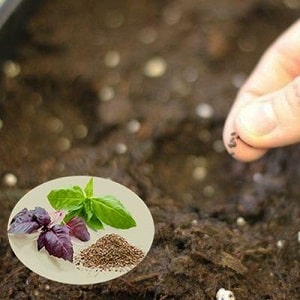 Basil seeds are sown to a depth of no more than 1 cm, in boxes - in rows at a distance of 10 cm. The best thing plant a crop into individual cassettes 5–7 cm high. Then the seedlings will not have to be thinned, injuring the roots.
Basil seeds are sown to a depth of no more than 1 cm, in boxes - in rows at a distance of 10 cm. The best thing plant a crop into individual cassettes 5–7 cm high. Then the seedlings will not have to be thinned, injuring the roots.
Plant the seeds in moist soil and cover with film or glass until germination.. Until this moment, the boxes with seedlings are kept in a warm, sunny place. As soon as the first shoots appear, the shelter is removed. Typically, greenery appears on the soil surface 7-8 days after planting.
Water the seedlings moderately, avoiding waterlogging or drying out.. In too humid environments, plants are damaged by blackleg, and in dry conditions they stop developing. When 2-3 true leaves appear, basil is picked into separate containers.
Reference. When to plant basil seeds in open ground? This is done only if the threat of frost has passed, in early June. However, the seedling method is more reliable.
Planting basil in open ground
The best precursors for spices - potatoes, cucumbers and legumes. You cannot plant basil in one place for several years in a row. This will lead to massive damage to plants by fusarium.
The most good neighbors - tomatoes. They contribute to the proper development of the crop and repel pests.
When to replant
2 months after germination, the basil is ready to be placed in the garden. In the southern regions, seedlings are planted in the ground in early May; in the Moscow region, in the Urals, in Western Siberia - in early June.
The further north the region and the higher the danger of frost, the later the basil is transplanted. If there is a threat of a sharp cold snap, the beds are covered with agril or film.
How to plant correctly
If there are a lot of seedlings, the strongest, most developed plants are selected. It is best to plant basil not in furrows, but in a square-cluster method - in holes at a distance of 15–20 cm from each other with row spacing of 30–40 cm.
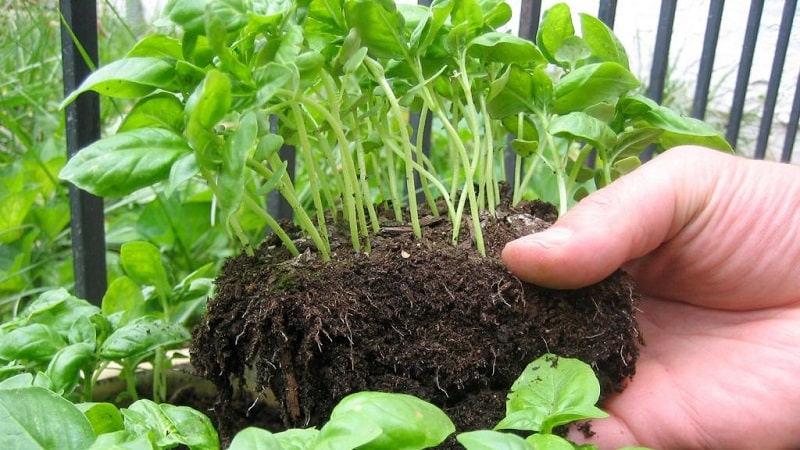
Basil requires light soil with drainage.. On stagnant and heavy soils, the crop develops poorly and grows slowly. She loves open sunny areas, but also grows well under young fruit trees without a spreading crown (apple trees, pears, cherries).
Interesting things on the site:
Basil "Basilisk" for marinades and fresh salads
Caring for Basil
To obtain a rich harvest, the plant is timely water, fertilize, protect from pests and diseases, loosen the soil. When properly cared for outdoors, basil grows strong, vibrant and healthy.
Watering
Moisten the soil regularly. Drying out leads to inhibition of plant growth and death. Thanks to regular watering, leaves form and grow quickly. The water needs to be settled and warm, not colder than +24…+25°C.
Loosening and mulching
Once every 1-2 weeks, harrow the soil and pull out weeds. Loosening is carried out before watering - this provides better nutrition to the root system.
The beds are mulched straw, sawdust or other available materials.The covered soil does not dry out and stops the development of weeds.
Topping
When flower stalks appear, they are cut off to encourage the plant to branch.. This will give an increase in green mass. Remove the tender top for maximum development of side shoots and a bountiful harvest, but do this not earlier than the basil reaches a height of 20–25 cm.
Top dressing
Fertilizers are applied for the first time 2 weeks after transplantation. basil in open ground. “Nitrophoska” is best suited. Water the plants at the rate of 3–5 liters per 1 m².
Subsequent feedings are carried out at intervals of a month, 2 times per season.. Apply "Nitrophoska" or organic fertilizers. Manure or humus is diluted with water in a ratio of 1:20 and left for at least a day.
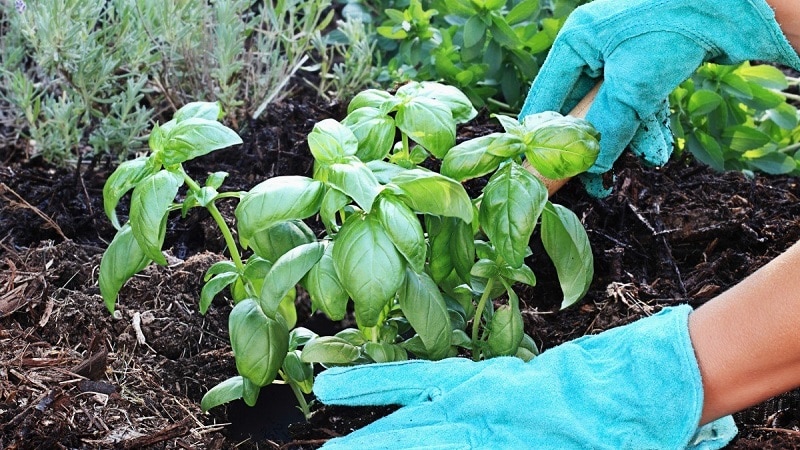
Prevention of diseases and pests
Black leg is dangerous for basil seedlings, which affects plants when there is excess moisture. To prevent the seedlings from dying, they are watered properly and the soil is loosened between the rows.
A sign of fusarium is the appearance of brown spots on the leaves. It occurs most often if basil is planted in the same bed for several years in a row.
Gray rot affects leaves and appears as small gray spots. All of these diseases lead to the death of plants, so at the first sign, urgent measures are taken.
Important! To prevent diseases, destroy weeds in a timely manner, loosen the soil, prevent it from becoming waterlogged, and thicken the plantings.
To protect the basil, it is processed:
- A strong infusion of onion peels. For 1 kg of scales, take 4 liters of water and leave for at least 24 hours. The resulting solution is sprayed onto the plants.
- To remove the blackleg, the soil is shed with a strong solution of potassium permanganate. If the disease has spread, the use of fungicides, for example, Fitosporin, will be required.
- Periodically (1-2 times a week) the soil in the garden bed is sprinkled with wood ash.
Basil is resistant to insect pests, but Aphids and field bugs sometimes settle on it. If there are plants on the site that are infected with aphids, a continuous treatment is carried out. It is almost impossible to get rid of it in a single bed - it is very prolific and easily moves from one plant to another.
Effective in the fight against aphids and field bugs insecticidal preparations. They treat the entire territory of the vegetable garden or garden. Natural enemies of aphids - ladybugs - are attracted to the site. They get rid of ants because they carry the pest from place to place.
The bug is afraid of birds, so the presence of 2-3 feeders on the site will protect against the pest more reliably than chemicals.
How does basil grow?
This is a plant of the Lamiaceae family with a tetrahedral stem, ovate leaves with serrated or entire edges. The culture grows up to 40–60 cm in height. The growing season is 140–160 days.
Stages of growth
Shoots after planting appear on days 7–9. After 2 weeks, 2-3 true leaves are formed. At first, the seedlings develop very slowly, so the basil is ready for transplanting only after 40–60 days.
The photo shows basil shoots.
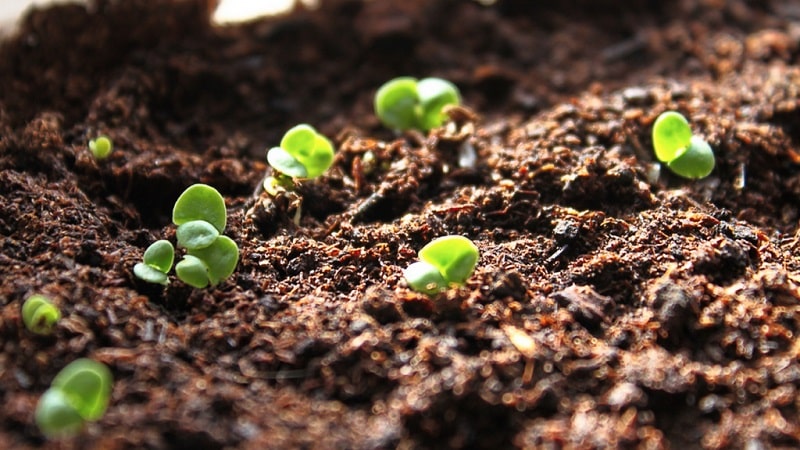
The plant blooms, depending on the region, from late June to late July.. The formation of buds continues until the end of August. After flowering ends in September, seeds are formed.
With proper care Plants are cut 3-4 times per season. About 90 days pass from the emergence of seedlings to the first harvest.
Basil propagation
The spice is grown in two ways - using seeds or cuttings. Seeds can be purchased at the store or grown independently.
Cuttings
To propagate this way you will need cut basil.. It can be bought at any supermarket or market. With this method, the harvest is obtained much earlier.
Selection and preparation of cuttings
Plants should not be very wilted. Any variety is suitable. To root, cut off all the side shoots from the branch and cut off the lower part under the leaf node with sharp scissors or a knife.
How to root
Prepared shoots are placed in a container of water and placed on the windowsill. If the sun is too bright, the plants are shaded to avoid burns and death.
After 10–14 days, numerous roots will appear on the lower part of the shoots. When they reach 3-4 cm, they are planted in pots for home breeding or in a garden bed.
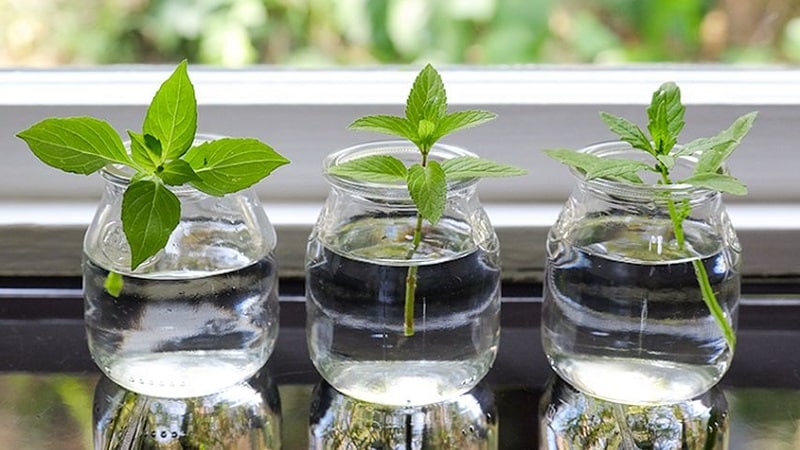
How to transplant basil into open ground
The layout of plants in the garden bed is the same as for seedlings: 15–20 cm between bushes and 30–40 cm between rows.
The cuttings are planted in moist soil, and the area is mulched with straw or sawdust.
Seeds
To obtain planting material, several rules are followed:
- On 2-3 bushes, the flower stalks are not cut off, but rather allowed to ripen.
- Choose the strongest, healthiest and harmoniously developed plants.
- When the seeds appear, excess flowers are removed so that the basil can concentrate on producing strong fruits.
- Readiness is determined by color: ripe seeds turn black.
- Fruits are collected only in dry, windless weather, otherwise there is a risk of them becoming moldy during storage.
- The flower stalks are cut off, wrapped in gauze, and tied into bundles.
- Hang upside down until completely dry.
- After 1-2 weeks, carefully unfold the gauze and select the seeds. Store away from sun, moisture and air.
Properly assembled planting material remains viable for 4-5 years.
Conclusion
Growing basil in the garden or at home is easy. The main thing is to create suitable conditions, know when to plant seedlings, do not forget to water the plants on time and follow other rules of agricultural technology. The aromatic spice is harvested 2-3 times per season.
Which propagation method to choose (seeds or cuttings) depends on the desire or availability of free time. Cuttings are a less time-consuming and much more reliable method.